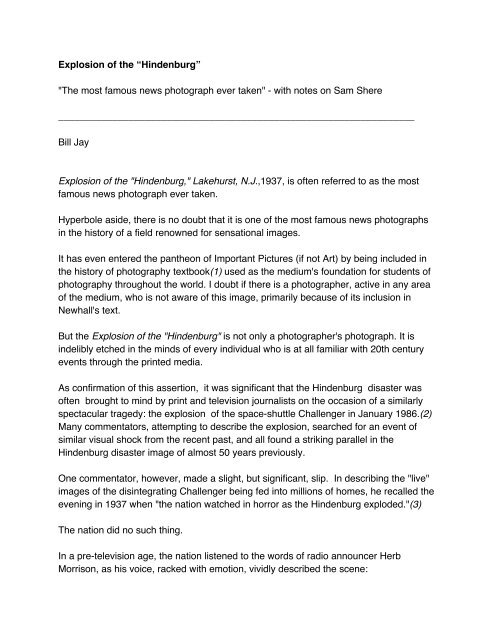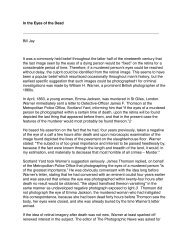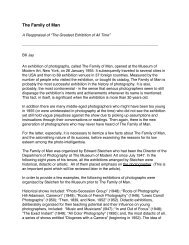Explosion of the “Hindenburg” - Bill Jay on Photography
Explosion of the “Hindenburg” - Bill Jay on Photography
Explosion of the “Hindenburg” - Bill Jay on Photography
Create successful ePaper yourself
Turn your PDF publications into a flip-book with our unique Google optimized e-Paper software.
<str<strong>on</strong>g>Explosi<strong>on</strong></str<strong>on</strong>g> <str<strong>on</strong>g>of</str<strong>on</strong>g> <str<strong>on</strong>g>the</str<strong>on</strong>g> <str<strong>on</strong>g>“Hindenburg”</str<strong>on</strong>g><br />
"The most famous news photograph ever taken" - with notes <strong>on</strong> Sam Shere<br />
__________________________________________________________________<br />
<str<strong>on</strong>g>Bill</str<strong>on</strong>g> <str<strong>on</strong>g>Jay</str<strong>on</strong>g><br />
<str<strong>on</strong>g>Explosi<strong>on</strong></str<strong>on</strong>g> <str<strong>on</strong>g>of</str<strong>on</strong>g> <str<strong>on</strong>g>the</str<strong>on</strong>g> "Hindenburg," Lakehurst, N.J.,1937, is <str<strong>on</strong>g>of</str<strong>on</strong>g>ten referred to as <str<strong>on</strong>g>the</str<strong>on</strong>g> most<br />
famous news photograph ever taken.<br />
Hyperbole aside, <str<strong>on</strong>g>the</str<strong>on</strong>g>re is no doubt that it is <strong>on</strong>e <str<strong>on</strong>g>of</str<strong>on</strong>g> <str<strong>on</strong>g>the</str<strong>on</strong>g> most famous news photographs<br />
in <str<strong>on</strong>g>the</str<strong>on</strong>g> history <str<strong>on</strong>g>of</str<strong>on</strong>g> a field renowned for sensati<strong>on</strong>al images.<br />
It has even entered <str<strong>on</strong>g>the</str<strong>on</strong>g> pan<str<strong>on</strong>g>the</str<strong>on</strong>g><strong>on</strong> <str<strong>on</strong>g>of</str<strong>on</strong>g> Important Pictures (if not Art) by being included in<br />
<str<strong>on</strong>g>the</str<strong>on</strong>g> history <str<strong>on</strong>g>of</str<strong>on</strong>g> photography textbook(1) used as <str<strong>on</strong>g>the</str<strong>on</strong>g> medium's foundati<strong>on</strong> for students <str<strong>on</strong>g>of</str<strong>on</strong>g><br />
photography throughout <str<strong>on</strong>g>the</str<strong>on</strong>g> world. I doubt if <str<strong>on</strong>g>the</str<strong>on</strong>g>re is a photographer, active in any area<br />
<str<strong>on</strong>g>of</str<strong>on</strong>g> <str<strong>on</strong>g>the</str<strong>on</strong>g> medium, who is not aware <str<strong>on</strong>g>of</str<strong>on</strong>g> this image, primarily because <str<strong>on</strong>g>of</str<strong>on</strong>g> its inclusi<strong>on</strong> in<br />
Newhall's text.<br />
But <str<strong>on</strong>g>the</str<strong>on</strong>g> <str<strong>on</strong>g>Explosi<strong>on</strong></str<strong>on</strong>g> <str<strong>on</strong>g>of</str<strong>on</strong>g> <str<strong>on</strong>g>the</str<strong>on</strong>g> "Hindenburg" is not <strong>on</strong>ly a photographer's photograph. It is<br />
indelibly etched in <str<strong>on</strong>g>the</str<strong>on</strong>g> minds <str<strong>on</strong>g>of</str<strong>on</strong>g> every individual who is at all familiar with 20th century<br />
events through <str<strong>on</strong>g>the</str<strong>on</strong>g> printed media.<br />
As c<strong>on</strong>firmati<strong>on</strong> <str<strong>on</strong>g>of</str<strong>on</strong>g> this asserti<strong>on</strong>, it was significant that <str<strong>on</strong>g>the</str<strong>on</strong>g> Hindenburg disaster was<br />
<str<strong>on</strong>g>of</str<strong>on</strong>g>ten brought to mind by print and televisi<strong>on</strong> journalists <strong>on</strong> <str<strong>on</strong>g>the</str<strong>on</strong>g> occasi<strong>on</strong> <str<strong>on</strong>g>of</str<strong>on</strong>g> a similarly<br />
spectacular tragedy: <str<strong>on</strong>g>the</str<strong>on</strong>g> explosi<strong>on</strong> <str<strong>on</strong>g>of</str<strong>on</strong>g> <str<strong>on</strong>g>the</str<strong>on</strong>g> space-shuttle Challenger in January 1986.(2)<br />
Many commentators, attempting to describe <str<strong>on</strong>g>the</str<strong>on</strong>g> explosi<strong>on</strong>, searched for an event <str<strong>on</strong>g>of</str<strong>on</strong>g><br />
similar visual shock from <str<strong>on</strong>g>the</str<strong>on</strong>g> recent past, and all found a striking parallel in <str<strong>on</strong>g>the</str<strong>on</strong>g><br />
Hindenburg disaster image <str<strong>on</strong>g>of</str<strong>on</strong>g> almost 50 years previously.<br />
One commentator, however, made a slight, but significant, slip. In describing <str<strong>on</strong>g>the</str<strong>on</strong>g> "live"<br />
images <str<strong>on</strong>g>of</str<strong>on</strong>g> <str<strong>on</strong>g>the</str<strong>on</strong>g> disintegrating Challenger being fed into milli<strong>on</strong>s <str<strong>on</strong>g>of</str<strong>on</strong>g> homes, he recalled <str<strong>on</strong>g>the</str<strong>on</strong>g><br />
evening in 1937 when "<str<strong>on</strong>g>the</str<strong>on</strong>g> nati<strong>on</strong> watched in horror as <str<strong>on</strong>g>the</str<strong>on</strong>g> Hindenburg exploded."(3)<br />
The nati<strong>on</strong> did no such thing.<br />
In a pre-televisi<strong>on</strong> age, <str<strong>on</strong>g>the</str<strong>on</strong>g> nati<strong>on</strong> listened to <str<strong>on</strong>g>the</str<strong>on</strong>g> words <str<strong>on</strong>g>of</str<strong>on</strong>g> radio announcer Herb<br />
Morris<strong>on</strong>, as his voice, racked with emoti<strong>on</strong>, vividly described <str<strong>on</strong>g>the</str<strong>on</strong>g> scene:
Oh, it's flashing, it's flashing terribly. It's bursting into flames and falling <strong>on</strong> <str<strong>on</strong>g>the</str<strong>on</strong>g><br />
mooring mast. Oh, this is <strong>on</strong>e <str<strong>on</strong>g>of</str<strong>on</strong>g> <str<strong>on</strong>g>the</str<strong>on</strong>g> worst catastrophes - <str<strong>on</strong>g>the</str<strong>on</strong>g> flames are leaping<br />
400, 500 feet into <str<strong>on</strong>g>the</str<strong>on</strong>g> sky. It's a terrific crash, ladies and gentlemen, <str<strong>on</strong>g>the</str<strong>on</strong>g> smoke<br />
and <str<strong>on</strong>g>the</str<strong>on</strong>g> flames. And now its crashing to <str<strong>on</strong>g>the</str<strong>on</strong>g> ground, not quite at <str<strong>on</strong>g>the</str<strong>on</strong>g> mooring<br />
mast. Oh, <str<strong>on</strong>g>the</str<strong>on</strong>g> humanity!<br />
It was <str<strong>on</strong>g>the</str<strong>on</strong>g>se words which <str<strong>on</strong>g>the</str<strong>on</strong>g> image, published in <str<strong>on</strong>g>the</str<strong>on</strong>g> next morning's newspapers,<br />
brought to life and made up-close and real. The potent combinati<strong>on</strong> <str<strong>on</strong>g>of</str<strong>on</strong>g> words and<br />
image, sound and sight, gave <str<strong>on</strong>g>the</str<strong>on</strong>g> Hindenburg photograph a special, unique power and<br />
propelled it even deeper into <str<strong>on</strong>g>the</str<strong>on</strong>g> minds <str<strong>on</strong>g>of</str<strong>on</strong>g> that and subsequent generati<strong>on</strong>s. Therefore,<br />
it is understandable that <str<strong>on</strong>g>the</str<strong>on</strong>g> Challenger commentator would substitute "watched" for<br />
"listened" because <str<strong>on</strong>g>the</str<strong>on</strong>g> still photograph <str<strong>on</strong>g>of</str<strong>on</strong>g> <str<strong>on</strong>g>the</str<strong>on</strong>g> crashing, fiery Hindenburg was so clearly<br />
etched in his mind. And, more significantly, he could assume that practically all his<br />
readers would share <str<strong>on</strong>g>the</str<strong>on</strong>g> same visual memory.<br />
<str<strong>on</strong>g>Explosi<strong>on</strong></str<strong>on</strong>g> <str<strong>on</strong>g>of</str<strong>on</strong>g> <str<strong>on</strong>g>the</str<strong>on</strong>g> <str<strong>on</strong>g>“Hindenburg”</str<strong>on</strong>g> had become an ic<strong>on</strong> for failed technology coupled with<br />
human tragedy. (4)<br />
The <str<strong>on</strong>g>“Hindenburg”</str<strong>on</strong>g> (5) was a self-propelled, steerable (dirigible) ballo<strong>on</strong> <str<strong>on</strong>g>of</str<strong>on</strong>g> fabric over a<br />
rigid frame. Lift was provided by hydrogen gas, which is more buoyant than<br />
n<strong>on</strong>flammable helium. It was an enormous craft, 803 feet in length and 137 feet in<br />
diameter. There was nothing unusual or experimental about its arrival in Lakehust, New<br />
Jersey, <strong>on</strong> <str<strong>on</strong>g>the</str<strong>on</strong>g> evening <str<strong>on</strong>g>of</str<strong>on</strong>g> 6 May 1937. It had already made 36 previous crossings <str<strong>on</strong>g>of</str<strong>on</strong>g> <str<strong>on</strong>g>the</str<strong>on</strong>g><br />
Atlantic with commercial passengers. This particular arrival was routine.<br />
The airship approached its mooring mask around 7:20 pm, hours later than scheduled<br />
due to wind and rain, and daylight was rapidly fading. There was some urgency <strong>on</strong> <str<strong>on</strong>g>the</str<strong>on</strong>g><br />
part <str<strong>on</strong>g>of</str<strong>on</strong>g> <str<strong>on</strong>g>the</str<strong>on</strong>g> ground crew because an electrical storm was still in <str<strong>on</strong>g>the</str<strong>on</strong>g> area, but <str<strong>on</strong>g>the</str<strong>on</strong>g> craft<br />
was being particularly truculent and p<strong>on</strong>derous to maneuver. Suddenly a finger <str<strong>on</strong>g>of</str<strong>on</strong>g> flame<br />
appeared and within sec<strong>on</strong>ds <str<strong>on</strong>g>the</str<strong>on</strong>g> Hindenburg exploded in a mass <str<strong>on</strong>g>of</str<strong>on</strong>g> flames.<br />
Passengers and crew were leaping from <str<strong>on</strong>g>the</str<strong>on</strong>g> g<strong>on</strong>dola in an attempt to escape <str<strong>on</strong>g>the</str<strong>on</strong>g> heat,<br />
risking a b<strong>on</strong>e-crushing death to being burned alive. Forty-seven sec<strong>on</strong>ds from <str<strong>on</strong>g>the</str<strong>on</strong>g> first<br />
spark <str<strong>on</strong>g>the</str<strong>on</strong>g> Hindenburg was a smoldering hulk <strong>on</strong> <str<strong>on</strong>g>the</str<strong>on</strong>g> ground.<br />
Of <str<strong>on</strong>g>the</str<strong>on</strong>g> ninety-seven people aboard <str<strong>on</strong>g>the</str<strong>on</strong>g> airship, thirty-six died, including its commander,<br />
Captain Ernst Lehmann.(6)<br />
Many books and articles have been written about this tragedy but rarely is <str<strong>on</strong>g>the</str<strong>on</strong>g><br />
photograph’s authorship in questi<strong>on</strong>. Even photographers familiar with <str<strong>on</strong>g>the</str<strong>on</strong>g> image in
Newhall’s textbook would be hard-pressed to name its maker. So who was <str<strong>on</strong>g>the</str<strong>on</strong>g><br />
photographer who made this famous picture? For reas<strong>on</strong>s which will quickly become<br />
apparent, this questi<strong>on</strong> does not have a simple answer.<br />
The credit line for <str<strong>on</strong>g>the</str<strong>on</strong>g> Hindenburg image in Newhall's textbook does include <str<strong>on</strong>g>the</str<strong>on</strong>g> name <str<strong>on</strong>g>of</str<strong>on</strong>g><br />
<str<strong>on</strong>g>the</str<strong>on</strong>g> author: Sam Shere. Shere's name <str<strong>on</strong>g>the</str<strong>on</strong>g>refore, should have entered <str<strong>on</strong>g>the</str<strong>on</strong>g> ranks <str<strong>on</strong>g>of</str<strong>on</strong>g> <str<strong>on</strong>g>the</str<strong>on</strong>g><br />
"greats" in photographic history, because Newhall's book is <str<strong>on</strong>g>the</str<strong>on</strong>g> single most influential<br />
text in <str<strong>on</strong>g>the</str<strong>on</strong>g> medium. Significantly, no details <str<strong>on</strong>g>of</str<strong>on</strong>g> Sam Shere, nor even his name, are<br />
menti<strong>on</strong>ed in <str<strong>on</strong>g>the</str<strong>on</strong>g> words which accompany <str<strong>on</strong>g>the</str<strong>on</strong>g> image. Shere's fame, such as it is, rests<br />
solely <strong>on</strong> <str<strong>on</strong>g>the</str<strong>on</strong>g> edge <str<strong>on</strong>g>of</str<strong>on</strong>g> a single image. Even <str<strong>on</strong>g>the</str<strong>on</strong>g> few photographers or historians who<br />
might recall Shere’s name would be hard-pressed to describe any o<str<strong>on</strong>g>the</str<strong>on</strong>g>r picture by this<br />
news photographer even though hehad a distinguished pr<str<strong>on</strong>g>of</str<strong>on</strong>g>essi<strong>on</strong>al career spanning<br />
more than 30 years.<br />
This fact may or may not be <str<strong>on</strong>g>of</str<strong>on</strong>g> importance, depending <strong>on</strong> <str<strong>on</strong>g>the</str<strong>on</strong>g> reader's philosophical<br />
attitudes toward <str<strong>on</strong>g>the</str<strong>on</strong>g> medium <str<strong>on</strong>g>of</str<strong>on</strong>g> photography. However, it does raise an intriguing issue<br />
in <str<strong>on</strong>g>the</str<strong>on</strong>g> field <str<strong>on</strong>g>of</str<strong>on</strong>g> photography in general: if its images can be so memorable without any<br />
interest in or knowledge <str<strong>on</strong>g>of</str<strong>on</strong>g> <str<strong>on</strong>g>the</str<strong>on</strong>g> author <str<strong>on</strong>g>the</str<strong>on</strong>g>n perhaps <str<strong>on</strong>g>the</str<strong>on</strong>g> cult <str<strong>on</strong>g>of</str<strong>on</strong>g> pers<strong>on</strong>ality fostered by<br />
academia is misplaced. Individuality <str<strong>on</strong>g>of</str<strong>on</strong>g> expressi<strong>on</strong>, <str<strong>on</strong>g>the</str<strong>on</strong>g> stress <strong>on</strong> authorship, <str<strong>on</strong>g>the</str<strong>on</strong>g><br />
emphasis <strong>on</strong> a pan<str<strong>on</strong>g>the</str<strong>on</strong>g><strong>on</strong> <str<strong>on</strong>g>of</str<strong>on</strong>g> master-photographers might all be irrelevant. But that is a<br />
topic for a separate discussi<strong>on</strong>. Its <strong>on</strong>ly relevance in this c<strong>on</strong>text is to widen <str<strong>on</strong>g>the</str<strong>on</strong>g> issue <str<strong>on</strong>g>of</str<strong>on</strong>g><br />
authorship when referring to <str<strong>on</strong>g>Explosi<strong>on</strong></str<strong>on</strong>g> <str<strong>on</strong>g>of</str<strong>on</strong>g> <str<strong>on</strong>g>the</str<strong>on</strong>g> <str<strong>on</strong>g>“Hindenburg”</str<strong>on</strong>g>.<br />
The issue is complicated by <str<strong>on</strong>g>the</str<strong>on</strong>g> fact that <str<strong>on</strong>g>the</str<strong>on</strong>g> Hindenburg image recalled by any<br />
individual might or might not have been taken by Sam Shere.<br />
Waiting for <str<strong>on</strong>g>the</str<strong>on</strong>g> <str<strong>on</strong>g>“Hindenburg”</str<strong>on</strong>g> to arrive at its mooring mast at Lakehurst, New Jersey,<br />
were about 22 still and newsreel cameramen. Practically all <str<strong>on</strong>g>of</str<strong>on</strong>g> <str<strong>on</strong>g>the</str<strong>on</strong>g>m took pictures <str<strong>on</strong>g>of</str<strong>on</strong>g> <str<strong>on</strong>g>the</str<strong>on</strong>g><br />
disaster. Nearly all <str<strong>on</strong>g>of</str<strong>on</strong>g> <str<strong>on</strong>g>the</str<strong>on</strong>g> still photographs are practically identical to each o<str<strong>on</strong>g>the</str<strong>on</strong>g>r;<br />
certainly it would be impossible to assess authorship from <str<strong>on</strong>g>the</str<strong>on</strong>g> intrinsic nature <str<strong>on</strong>g>of</str<strong>on</strong>g> <str<strong>on</strong>g>the</str<strong>on</strong>g><br />
images.<br />
Merely as a few examples, we can name several photographers whose pictures <str<strong>on</strong>g>of</str<strong>on</strong>g> <str<strong>on</strong>g>the</str<strong>on</strong>g><br />
<str<strong>on</strong>g>“Hindenburg”</str<strong>on</strong>g> crash are as similar to Shere's as two peas in a pod: Charles H<str<strong>on</strong>g>of</str<strong>on</strong>g>f <str<strong>on</strong>g>of</str<strong>on</strong>g> <str<strong>on</strong>g>the</str<strong>on</strong>g><br />
New York Daily News; Gus Pasquarella <str<strong>on</strong>g>of</str<strong>on</strong>g> <str<strong>on</strong>g>the</str<strong>on</strong>g> Philadelphia Bulletin; <str<strong>on</strong>g>Bill</str<strong>on</strong>g> Springfield <str<strong>on</strong>g>of</str<strong>on</strong>g><br />
Acme-NEA; Jack Snyder <str<strong>on</strong>g>of</str<strong>on</strong>g> <str<strong>on</strong>g>the</str<strong>on</strong>g> Philadelphia Record. Then <str<strong>on</strong>g>the</str<strong>on</strong>g>re was Murray Becker, <str<strong>on</strong>g>of</str<strong>on</strong>g><br />
Associated Press, whose picture <str<strong>on</strong>g>of</str<strong>on</strong>g> <str<strong>on</strong>g>the</str<strong>on</strong>g> disaster was selected for publicati<strong>on</strong> in Great<br />
News Photos.(7)<br />
In fact <str<strong>on</strong>g>the</str<strong>on</strong>g>re was almost a surfeit <str<strong>on</strong>g>of</str<strong>on</strong>g> pictures, by so many photographers, <str<strong>on</strong>g>of</str<strong>on</strong>g> <str<strong>on</strong>g>the</str<strong>on</strong>g>
Hindenburg crash; perhaps never before had a disaster been so thoroughly<br />
documented by <str<strong>on</strong>g>the</str<strong>on</strong>g> camera. The next morning, <str<strong>on</strong>g>the</str<strong>on</strong>g> New York newspapers were full <str<strong>on</strong>g>of</str<strong>on</strong>g><br />
<str<strong>on</strong>g>the</str<strong>on</strong>g> images; <str<strong>on</strong>g>the</str<strong>on</strong>g> World-Telegram carried no less that twenty-<strong>on</strong>e pictures <str<strong>on</strong>g>of</str<strong>on</strong>g> <str<strong>on</strong>g>the</str<strong>on</strong>g> flaming<br />
Hindenburg and its survivors. The New York Post ran <str<strong>on</strong>g>the</str<strong>on</strong>g> photographers over seven<br />
papers, <str<strong>on</strong>g>the</str<strong>on</strong>g> Daily Mirror, nine. The story, and <str<strong>on</strong>g>the</str<strong>on</strong>g> pictures, appeared in newspapers<br />
everywhere. The New York Sunday Mirror even ran full color shots in its 23 May issue,<br />
taken by Gerry Sheedy <strong>on</strong> 35 mm Kodachrome.<br />
Any <strong>on</strong>e <str<strong>on</strong>g>of</str<strong>on</strong>g> <str<strong>on</strong>g>the</str<strong>on</strong>g>se photographers might have taken <str<strong>on</strong>g>the</str<strong>on</strong>g> image <str<strong>on</strong>g>of</str<strong>on</strong>g> <str<strong>on</strong>g>the</str<strong>on</strong>g> <str<strong>on</strong>g>“Hindenburg”</str<strong>on</strong>g><br />
explosi<strong>on</strong> which is so clearly etched in any viewer's mind. More likely, our memory is an<br />
amalgam <str<strong>on</strong>g>of</str<strong>on</strong>g> several pictures by different photographers seen over <str<strong>on</strong>g>the</str<strong>on</strong>g> years in different<br />
circumstances.<br />
But it is Sam Shere’s image which is featured in The History <str<strong>on</strong>g>of</str<strong>on</strong>g> <strong>Photography</strong> and for this<br />
reas<strong>on</strong> it is appropriate to add a few details <str<strong>on</strong>g>of</str<strong>on</strong>g> his life and career.<br />
Sam Shere<br />
Born Samuel Shereshewsky, in Minsk, Russia, c.1904, Shere was brought to America<br />
by his orthodox Jewish parents and grew up in <str<strong>on</strong>g>the</str<strong>on</strong>g> Lower East Side <str<strong>on</strong>g>of</str<strong>on</strong>g> New York City.<br />
His fa<str<strong>on</strong>g>the</str<strong>on</strong>g>r was a hat maker, who wanted his s<strong>on</strong> to be a doctor. Unfortunately, young<br />
Samuel could <strong>on</strong>ly tolerate school until <str<strong>on</strong>g>the</str<strong>on</strong>g> seventh grade.<br />
His first job was carrying a tripod for Pa<str<strong>on</strong>g>the</str<strong>on</strong>g> News cameramen, at a wage <str<strong>on</strong>g>of</str<strong>on</strong>g> a dollar a<br />
day, plus lunch. After following <str<strong>on</strong>g>the</str<strong>on</strong>g> cameramen to five-alarm fires, naval yards, and<br />
parades, he was settled in his career; he wanted to be a news photographer.<br />
Resigned to young Sam's choice <str<strong>on</strong>g>of</str<strong>on</strong>g> a pr<str<strong>on</strong>g>of</str<strong>on</strong>g>essi<strong>on</strong>, his fa<str<strong>on</strong>g>the</str<strong>on</strong>g>r bought him a 4x 5 inch<br />
Speed Graphic, <str<strong>on</strong>g>the</str<strong>on</strong>g> standard equipment for a newspaper photographer at <str<strong>on</strong>g>the</str<strong>on</strong>g> end <str<strong>on</strong>g>of</str<strong>on</strong>g><br />
World War I (1918). Within a year, Sam had sold his first photograph: a picture <str<strong>on</strong>g>of</str<strong>on</strong>g> a<br />
young girl walking across <str<strong>on</strong>g>the</str<strong>on</strong>g> Brooklyn Bridge to Manhattan during a New York<br />
snowstorm. The New York Illustrated Daily News bought <str<strong>on</strong>g>the</str<strong>on</strong>g> picture for $7.00.<br />
At this time, however, Sam's interest in photography was in c<strong>on</strong>flict with his even<br />
greater interest in going to sea. He signed <strong>on</strong> as a mess-boy with oil tankers plying<br />
between New Jersey and California via <str<strong>on</strong>g>the</str<strong>on</strong>g> Panama Canal. Even though he spent<br />
most <str<strong>on</strong>g>of</str<strong>on</strong>g> his time <strong>on</strong> board ship for <str<strong>on</strong>g>the</str<strong>on</strong>g> next 10 years he quickly found that life at sea<br />
was not incompatible with pr<str<strong>on</strong>g>of</str<strong>on</strong>g>essi<strong>on</strong>al photography. He so<strong>on</strong> had an <strong>on</strong>~ship<br />
darkroom and managed to freelance during stays in port.<br />
One <str<strong>on</strong>g>of</str<strong>on</strong>g> <str<strong>on</strong>g>the</str<strong>on</strong>g>se stays lasted for a year, in 1923, when Sam Shere (<str<strong>on</strong>g>the</str<strong>on</strong>g> name had been
abbreviated <str<strong>on</strong>g>the</str<strong>on</strong>g> previous year) became a photographer for <str<strong>on</strong>g>the</str<strong>on</strong>g> New York Evening<br />
Graphic for $50.00 per week. But he was so<strong>on</strong> missing <str<strong>on</strong>g>the</str<strong>on</strong>g> smell <str<strong>on</strong>g>of</str<strong>on</strong>g> <str<strong>on</strong>g>the</str<strong>on</strong>g> sea, and<br />
signed aboard <str<strong>on</strong>g>the</str<strong>on</strong>g> S.S. George Washingt<strong>on</strong> as ship's photographer. After <strong>on</strong>e<br />
transatlantic crossing, he visited Germany and bought <strong>on</strong>e <str<strong>on</strong>g>of</str<strong>on</strong>g> <str<strong>on</strong>g>the</str<strong>on</strong>g> new Leica 35 mm<br />
cameras, for $42.00 "and spent <str<strong>on</strong>g>the</str<strong>on</strong>g> next few years <strong>on</strong> <str<strong>on</strong>g>the</str<strong>on</strong>g> o<str<strong>on</strong>g>the</str<strong>on</strong>g>r end <str<strong>on</strong>g>of</str<strong>on</strong>g> ridicule,<br />
enduring sarcastic remarks and innuendoes from American news photographers who<br />
regarded <str<strong>on</strong>g>the</str<strong>on</strong>g> Leica as a 'toy'." In spite <str<strong>on</strong>g>of</str<strong>on</strong>g> <str<strong>on</strong>g>the</str<strong>on</strong>g> c<strong>on</strong>stant ribbing Sam Shere persisted in<br />
carrying <str<strong>on</strong>g>the</str<strong>on</strong>g> Leica everywhere, al<strong>on</strong>g with <str<strong>on</strong>g>the</str<strong>on</strong>g> Speed Graphic, and is now credited with<br />
pi<strong>on</strong>eering <str<strong>on</strong>g>the</str<strong>on</strong>g> use <str<strong>on</strong>g>of</str<strong>on</strong>g> <str<strong>on</strong>g>the</str<strong>on</strong>g> discreet 35 mm camera in American news photography.<br />
In 1926 Sam Shere became ship's photographer for <str<strong>on</strong>g>the</str<strong>on</strong>g> S.S. Leviathan (flagship <str<strong>on</strong>g>of</str<strong>on</strong>g> <str<strong>on</strong>g>the</str<strong>on</strong>g><br />
United States Line). He made good m<strong>on</strong>ey for those days, earning $300-400 per<br />
round trip across <str<strong>on</strong>g>the</str<strong>on</strong>g> Atlantic, by selling pictures to <str<strong>on</strong>g>the</str<strong>on</strong>g> passengers as momentoes <str<strong>on</strong>g>of</str<strong>on</strong>g><br />
<str<strong>on</strong>g>the</str<strong>on</strong>g> voyage, public relati<strong>on</strong>s shots for <str<strong>on</strong>g>the</str<strong>on</strong>g> shipping line, portraits <str<strong>on</strong>g>of</str<strong>on</strong>g> notable passengers,<br />
and scenics <str<strong>on</strong>g>of</str<strong>on</strong>g> icebergs and storms. Altoge<str<strong>on</strong>g>the</str<strong>on</strong>g>r Shere made 126 crossings <str<strong>on</strong>g>of</str<strong>on</strong>g> <str<strong>on</strong>g>the</str<strong>on</strong>g><br />
Atlantic <strong>on</strong> <str<strong>on</strong>g>the</str<strong>on</strong>g> Leviathan. While disembarked in Europe, waiting for <str<strong>on</strong>g>the</str<strong>on</strong>g> return voyage,<br />
he began freelance work for <str<strong>on</strong>g>the</str<strong>on</strong>g> prestigious Internati<strong>on</strong>al News Photo, a part <str<strong>on</strong>g>of</str<strong>on</strong>g> <str<strong>on</strong>g>the</str<strong>on</strong>g><br />
William Randolph Hearst publishing empire.<br />
In 1934 Sam Shere left <str<strong>on</strong>g>the</str<strong>on</strong>g> sea to take a full time positi<strong>on</strong> with I.N.P. It was also <str<strong>on</strong>g>the</str<strong>on</strong>g><br />
year that Shere’s persistence with <str<strong>on</strong>g>the</str<strong>on</strong>g> Leica led to a celebrated scoop. During <str<strong>on</strong>g>the</str<strong>on</strong>g> first<br />
arraignment <str<strong>on</strong>g>of</str<strong>on</strong>g> Bruno Richard Hauptmann a suspect in <str<strong>on</strong>g>the</str<strong>on</strong>g> Lindberg kidnapping case,<br />
Shere smuggled his small camera into <str<strong>on</strong>g>the</str<strong>on</strong>g> court room and, unnoticed, shot exclusive<br />
pictures <str<strong>on</strong>g>of</str<strong>on</strong>g> <str<strong>on</strong>g>the</str<strong>on</strong>g> proceedings. The Leica was also used <str<strong>on</strong>g>the</str<strong>on</strong>g> following year for a major<br />
story <strong>on</strong> <str<strong>on</strong>g>the</str<strong>on</strong>g> inside Sing Sing pris<strong>on</strong>. Shere claimed that <str<strong>on</strong>g>the</str<strong>on</strong>g> series would have been a<br />
total failure if it had not been for <str<strong>on</strong>g>the</str<strong>on</strong>g> speed, ease and silence <str<strong>on</strong>g>of</str<strong>on</strong>g> <str<strong>on</strong>g>the</str<strong>on</strong>g> miniature camera.<br />
"(It) gave me mobility and did not attract much attenti<strong>on</strong> from <str<strong>on</strong>g>the</str<strong>on</strong>g> inmates. I was able<br />
to film, for <str<strong>on</strong>g>the</str<strong>on</strong>g> first time, candid shots <str<strong>on</strong>g>of</str<strong>on</strong>g> <str<strong>on</strong>g>the</str<strong>on</strong>g> pris<strong>on</strong>'s rock pile, fire department, flagmaking<br />
shop, a cell block, <str<strong>on</strong>g>the</str<strong>on</strong>g> pris<strong>on</strong> parade, <str<strong>on</strong>g>the</str<strong>on</strong>g> warden's <str<strong>on</strong>g>of</str<strong>on</strong>g>fice, <str<strong>on</strong>g>the</str<strong>on</strong>g> executi<strong>on</strong><br />
chamber and adjacent autopsy rooms... My ‘toy’ was gaining its place in news<br />
photography through <str<strong>on</strong>g>the</str<strong>on</strong>g>se series."<br />
By 1937, <str<strong>on</strong>g>the</str<strong>on</strong>g> date <str<strong>on</strong>g>of</str<strong>on</strong>g> <str<strong>on</strong>g>the</str<strong>on</strong>g> Hindenburg's explosi<strong>on</strong>, Sam Shere had paid his dues as a<br />
news photographer, with both 4x5 inch and 35 mm formats. He was not <strong>on</strong>ly in <str<strong>on</strong>g>the</str<strong>on</strong>g> right<br />
place at <str<strong>on</strong>g>the</str<strong>on</strong>g> right time, but also he was "primed" to take picture advantage <str<strong>on</strong>g>of</str<strong>on</strong>g> every<br />
situati<strong>on</strong>, such as Hindenburg’s arrival.<br />
Ir<strong>on</strong>ically, Sam Shere was reluctant to take <str<strong>on</strong>g>the</str<strong>on</strong>g> assignment, which was c<strong>on</strong>sidered a<br />
routine <strong>on</strong>e. He had been assigned by his editor at Internati<strong>on</strong>al News Photos to get<br />
some good "society type" shots <str<strong>on</strong>g>of</str<strong>on</strong>g> <str<strong>on</strong>g>the</str<strong>on</strong>g> celebrities leaving <str<strong>on</strong>g>the</str<strong>on</strong>g> airship. Shere recalled: "I
had come to think <str<strong>on</strong>g>of</str<strong>on</strong>g> myself as a "hard news' photographer, and sort <str<strong>on</strong>g>of</str<strong>on</strong>g> resented <str<strong>on</strong>g>the</str<strong>on</strong>g><br />
assignment. “I just wanted to get my pictures and get out <str<strong>on</strong>g>of</str<strong>on</strong>g> <str<strong>on</strong>g>the</str<strong>on</strong>g>re." (8) After waiting for<br />
over three hours in drizzling rain, <str<strong>on</strong>g>the</str<strong>on</strong>g> airship came into view through <str<strong>on</strong>g>the</str<strong>on</strong>g> evening murk.<br />
Suddenly <str<strong>on</strong>g>the</str<strong>on</strong>g> dirigible exploded. Shere said: "I had two shots in my big Speed Graphic,<br />
but I didn't even have time to get it up to my eye. I literally 'shot’ from <str<strong>on</strong>g>the</str<strong>on</strong>g> hip - it was<br />
over so fast <str<strong>on</strong>g>the</str<strong>on</strong>g>re was nothing else to do." Out <str<strong>on</strong>g>of</str<strong>on</strong>g> 4 x 5 film, Shere switched to his Leica<br />
and began taking shots <str<strong>on</strong>g>of</str<strong>on</strong>g> <str<strong>on</strong>g>the</str<strong>on</strong>g> passengers and crew members fleeing <str<strong>on</strong>g>the</str<strong>on</strong>g> wreckage.<br />
"Only <strong>on</strong>e <str<strong>on</strong>g>of</str<strong>on</strong>g> <str<strong>on</strong>g>the</str<strong>on</strong>g>se pictures, <str<strong>on</strong>g>the</str<strong>on</strong>g>y were so ghastly, so graphic, was ever used...” (9)<br />
Asked to comment <strong>on</strong> <str<strong>on</strong>g>the</str<strong>on</strong>g> significance, and fame, <str<strong>on</strong>g>of</str<strong>on</strong>g> his photograph, Shere replied:<br />
"Many photographers got similar shots. I guess I was just lucky to be in <str<strong>on</strong>g>the</str<strong>on</strong>g> right place<br />
at <str<strong>on</strong>g>the</str<strong>on</strong>g> right time. I d<strong>on</strong>'t really think it my most singular feat." (10)<br />
After 1937, Shere's career as a news photographer was extraordinarily varied. A mere<br />
list <str<strong>on</strong>g>of</str<strong>on</strong>g> his assignments would occupy too many pages. A few highlights include: a story<br />
<strong>on</strong> <str<strong>on</strong>g>the</str<strong>on</strong>g> return <str<strong>on</strong>g>of</str<strong>on</strong>g> Wr<strong>on</strong>g-Way Corrigan using carrier pige<strong>on</strong>s to deliver negatives from<br />
<str<strong>on</strong>g>the</str<strong>on</strong>g> SS Manhattan to New York (1938); photographing <str<strong>on</strong>g>the</str<strong>on</strong>g> Duke <str<strong>on</strong>g>of</str<strong>on</strong>g> Windsor, who had<br />
abdicated his thr<strong>on</strong>e, in <str<strong>on</strong>g>the</str<strong>on</strong>g> Bahamas (1940); an Atlantic Air Patrol which was cited as<br />
<str<strong>on</strong>g>the</str<strong>on</strong>g> most outstanding news event <str<strong>on</strong>g>of</str<strong>on</strong>g> <str<strong>on</strong>g>the</str<strong>on</strong>g> year (1941; <str<strong>on</strong>g>the</str<strong>on</strong>g> World War II invasi<strong>on</strong> <str<strong>on</strong>g>of</str<strong>on</strong>g> Sicily<br />
(1942); several stories for Life beginning more than a decade <str<strong>on</strong>g>of</str<strong>on</strong>g> work for this magazine<br />
(1943); <str<strong>on</strong>g>the</str<strong>on</strong>g> Lepke executi<strong>on</strong> and Dewey presidential campaign (1944); VE Day<br />
reacti<strong>on</strong> and Pearl Harbor investigati<strong>on</strong> (1945); death <str<strong>on</strong>g>of</str<strong>on</strong>g> Al Cap<strong>on</strong>e (1947); c<strong>on</strong>structi<strong>on</strong><br />
<str<strong>on</strong>g>of</str<strong>on</strong>g> <str<strong>on</strong>g>the</str<strong>on</strong>g> SS United States (1948); and so <strong>on</strong>. (11)<br />
Sam Shere shot his last assignment in Ireland at <str<strong>on</strong>g>the</str<strong>on</strong>g> age <str<strong>on</strong>g>of</str<strong>on</strong>g> 75. He died in poverty in<br />
government housing <strong>on</strong> 8 July 1982.<br />
References and footnotes:<br />
1. Beaum<strong>on</strong>t Newhall, The History <str<strong>on</strong>g>of</str<strong>on</strong>g> <strong>Photography</strong>, 5th editi<strong>on</strong>,N.Y.,1982, p. 257.<br />
2. For example: T. A. Heppenheimer, "Time to call <str<strong>on</strong>g>the</str<strong>on</strong>g> shuttle obsolete," Manchester<br />
Guardian Weekly, 9 February 1986, p.7. The first two paragraphs <str<strong>on</strong>g>of</str<strong>on</strong>g> this article recount<br />
<str<strong>on</strong>g>the</str<strong>on</strong>g> story <str<strong>on</strong>g>of</str<strong>on</strong>g> <str<strong>on</strong>g>the</str<strong>on</strong>g> Hindenburg crash.<br />
3. Michael Collins, "After <str<strong>on</strong>g>the</str<strong>on</strong>g> Challenger Disaster", The Washingt<strong>on</strong> Post.<br />
4. Heppenheimer wrote: "The Hindenburg exposed <str<strong>on</strong>g>the</str<strong>on</strong>g> flaws in <str<strong>on</strong>g>the</str<strong>on</strong>g> dirigible as a<br />
passenger carrier, showing it to be an obsolete technology that could not compete with<br />
its rival, <str<strong>on</strong>g>the</str<strong>on</strong>g> airplane. The Challenger disaster, in turn, will point to <str<strong>on</strong>g>the</str<strong>on</strong>g> Shuttle<br />
as a technology that is not <strong>on</strong>ly obsolete but also irrelevant."<br />
5. The Hindenburg was named after Paul V<strong>on</strong> Hindenburg (1847-1937) a field-marshal<br />
and president <str<strong>on</strong>g>of</str<strong>on</strong>g> Germany from 1925. He defeated Adolf Hitler in <str<strong>on</strong>g>the</str<strong>on</strong>g> presidential<br />
electi<strong>on</strong>s <str<strong>on</strong>g>of</str<strong>on</strong>g> 1932 but, in January 1933, through political intrigues, was persuaded to
appoint Hitler as chancellor.<br />
6. The Hindenburg was owned and operated as a transatlantic passenger service by <str<strong>on</strong>g>the</str<strong>on</strong>g><br />
German Zeppelin Transport Company.<br />
7. Great News Photos and <str<strong>on</strong>g>the</str<strong>on</strong>g> stories behind <str<strong>on</strong>g>the</str<strong>on</strong>g>m, by John Faber, Dover Publicati<strong>on</strong>s,<br />
Inc., New York, number 31.<br />
8. Interview with Sam Shere, by Joanne Kash, Art Voices/South, November/December,<br />
1980, p. 41-42.<br />
9. Ibid.<br />
10. Ibid.<br />
11. An extensive chr<strong>on</strong>ology is included in On Assignment: Photographs by Sam Shere,<br />
Museum <str<strong>on</strong>g>of</str<strong>on</strong>g> Fine Arts, St. Petersburg, Florida, 1978.<br />
First published in Newsletter, Dayt<strong>on</strong>a Beach Community College,Spring/Summer 1989, pp. 22-24.





